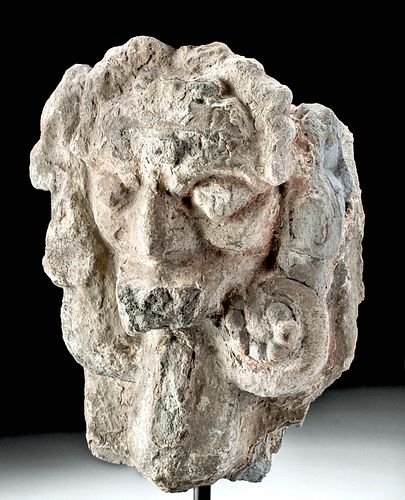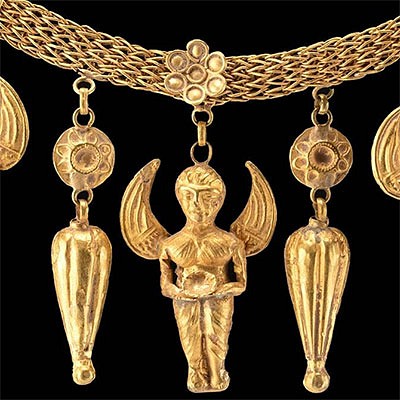Rare Maya Stucco Stone Wind Deity, Ex Denver Museum
Lot 90b
About Seller
Artemis Gallery
686 S Taylor Ave, Ste 106
Louisville, CO 80027
United States
Selling antiquities, ancient and ethnographic art online since 1993, Artemis Gallery specializes in Classical Antiquities (Egyptian, Greek, Roman, Near Eastern), Asian, Pre-Columbian, African / Tribal / Oceanographic art. Our extensive inventory includes pottery, stone, metal, wood, glass and textil...Read more
Estimate:
$4,500 - $6,500
Absentee vs Live bid
Two ways to bid:
- Leave a max absentee bid and the platform will bid on your behalf up to your maximum bid during the live auction.
- Bid live during the auction and your bids will be submitted real-time to the auctioneer.
Bid Increments
| Price | Bid Increment |
|---|---|
| $0 | $25 |
| $300 | $50 |
| $1,000 | $100 |
| $2,000 | $250 |
| $5,000 | $500 |
| $10,000 | $1,000 |
| $20,000 | $2,500 |
| $50,000 | $5,000 |
| $100,000 | $10,000 |
| $200,000 | $20,000 |
About Auction
By Artemis Gallery
Dec 3, 2020
Set Reminder
2020-12-03 10:00:00
2020-12-03 10:00:00
America/New_York
Bidsquare
Bidsquare : Fine Antiquities, Ethnographic & Fine Art
https://www.bidsquare.com/auctions/artemis-gallery/fine-antiquities-ethnographic-fine-art-6119
Features classical antiquities, ancient and ethnographic art from cultures encompassing the globe. Egyptian, Greek, Roman, Etruscan, Near Eastern, Asian, Pre-Columbian, Native American, African / Tribal, Oceanic, Spanish Colonial, Russian, Fine Art, so much more! All legally acquired, legal to sell. Artemis Gallery info@artemisgallery.com
Features classical antiquities, ancient and ethnographic art from cultures encompassing the globe. Egyptian, Greek, Roman, Etruscan, Near Eastern, Asian, Pre-Columbian, Native American, African / Tribal, Oceanic, Spanish Colonial, Russian, Fine Art, so much more! All legally acquired, legal to sell. Artemis Gallery info@artemisgallery.com
- Lot Description
Pre-Columbian, Southern Mexico, Campeche or Chiapas, Mayan Territories, Classic Period, ca. 400 to 900 CE. A hand carved anthropomorphic stone and stucco head of the Maya wind deity, Ik' K'uh, comprised of exaggerated facial features to emphasize his aspects. His lower appendage, perhaps lip and tongue, hang vertically down below a projecting "duck bill" upper lip. The curling emanations to the sides of the open mouth, one of which still shows the beaded detail, indicates water or blood. A naturalistic nose is set between the bulging eyes, that stare intently forward above high cheekbones, framed by a scalloped headdress. The left eye still shows the original "T" shape incised carving which is the Maya symbol for wind. No doubt the right eye was similarly incised, but it has weathered more strongly. This is a significant stucco sculpture of a relatively unknown Maya deity! Size: 10" W x 13" H (25.4 cm x 33 cm); 15.5" H (39.4 cm) on included custom stand.
The "T" is the symbol for the maya word "ik" meaning both wind and breath, but also had other more ambiguous meanings. Ik' K'uh is the wind and music deity that embodied the breath or spirit, which sustains the gods and invigorates their spiritual force. Breath and breathing marked the difference between life and death. Despite being a destructive force of nature, wind was also life affirming aspect. Wind instruments were important part of ritual use in Maya culture, drawing a connection between human breath, the energy force, creating sound, or giving life to an otherwise intimate object.
Provenance: ex-Denver Museum of Art, deaccessioned 1980s
All items legal to buy/sell under U.S. Statute covering cultural patrimony Code 2600, CHAPTER 14, and are guaranteed to be as described or your money back.
A Certificate of Authenticity will accompany all winning bids.
We ship worldwide and handle all shipping in-house for your convenience.
#159707Fragment from a larger piece. Abrasions and losses to high relief peripheries. Surface weathering, crumbling, and softening of details. Backside has a modern wire attached with plaster from mounting it. Mineral deposits and traces of painted pigment!Condition
- Shipping Info
-
All shipping is handled in-house for your convenience. Your invoice from Artemis Gallery will include shipping calculation instructions. If in doubt, please inquire BEFORE bidding for estimated shipping costs for individual items.
-
- Buyer's Premium



 EUR
EUR CAD
CAD AUD
AUD GBP
GBP MXN
MXN HKD
HKD CNY
CNY MYR
MYR SEK
SEK SGD
SGD CHF
CHF THB
THB














